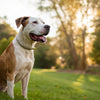Do Female Dogs Gain Weight When in Heat? Understanding the Changes in Your Dog's Body
- Houndsy
Table of Contents
- Introduction
- The Stages of a Female Dog's Heat Cycle
- Hormonal Changes During Estrus
- Behavioral and Physical Changes in Dogs During Heat
- Do Female Dogs Gain Weight When in Heat?
- Tips for Managing Your Dog’s Diet and Health During Heat
- Conclusion
- FAQ
Introduction
As pet owners, we often find ourselves puzzled by the myriad of changes our furry companions go through. Have you ever noticed your female dog looking a bit heavier or acting differently when she’s in heat? Understanding these changes can be crucial for ensuring her health and well-being. In fact, studies suggest that hormonal fluctuations during the heat cycle can lead to noticeable weight changes in female dogs, along with other physical and behavioral shifts.
In this blog post, we will explore the intricacies of a female dog's heat cycle, particularly focusing on whether female dogs gain weight when in heat. We will delve into the hormonal changes involved, the signs of heat, and how these can affect your dog's appetite and weight. By the end, we aim to provide you with a comprehensive understanding of this natural process, empowering you to care for your dog more effectively during this time.
We will cover the following aspects:
- The stages of a female dog’s heat cycle
- The hormonal changes that occur during estrus
- Behavioral and physical changes in dogs during heat
- The relationship between heat and weight gain
- Tips for managing your dog’s diet and health during this period
Let’s embark on this journey to enhance our knowledge of female dogs in heat and ensure their comfort and health.
The Stages of a Female Dog's Heat Cycle
Understanding the heat cycle is essential for dog owners. The estrous cycle in female dogs consists of four distinct stages: proestrus, estrus, diestrus, and anestrus. Each stage has unique characteristics and lasts for varying durations.
1. Proestrus
This is the initial stage of the heat cycle, lasting about 7 to 10 days. During proestrus, you may notice the following signs:
- Swollen Vulva: The vulva becomes noticeably enlarged and may have a reddish tinge.
- Bloody Discharge: There may be a bloody discharge from the vagina, although not all dogs exhibit this symptom.
- Behavioral Changes: Dogs may become more affectionate or clingy, seeking attention and comfort.
2. Estrus
The estrus stage, commonly referred to as the "heat" stage, lasts about 5 to 10 days. This is when the female dog is receptive to mating. Key indicators include:
- Reduced Discharge: The bloody discharge may lighten or stop altogether.
- Increased Urination: Dogs may urinate more frequently to mark territory and attract males.
- Behavioral Changes: Females may exhibit flagging behavior, turning their tails to the side to signal readiness to mate.
3. Diestrus
Following estrus, the diestrus stage can last from 10 to 140 days. During this phase, the dog’s body prepares for potential pregnancy. Signs include:
- Hormonal Fluctuations: Hormone levels stabilize as the body prepares for either pregnancy or the next cycle.
- Decreased Interest in Mating: The female will no longer attract males.
4. Anestrus
This is the resting phase between cycles, lasting about six months. During anestrus, the dog shows no sexual signs or behaviors, and her body recovers from the previous cycle.
Hormonal Changes During Estrus
During the heat cycle, especially in the estrus stage, a female dog's hormones undergo significant fluctuations. The primary hormones involved are estrogen and progesterone.
- Estrogen: Levels peak during proestrus and estrus, leading to physical changes such as increased blood flow to the vulva and behavioral shifts that attract male dogs.
- Progesterone: After ovulation, progesterone levels rise in anticipation of possible pregnancy. This hormone can also affect appetite, sometimes leading to weight gain.
These hormonal changes can significantly influence your dog’s behavior and physical condition. Understanding these factors is essential to managing your dog’s health during her heat cycle.
Behavioral and Physical Changes in Dogs During Heat
As responsible pet owners, it’s vital to recognize the myriad of behavioral and physical changes that occur when a female dog is in heat.
Behavioral Changes
- Increased Affection: Many dogs become more affectionate during this time, seeking more attention from their owners.
- Restlessness: Increased energy levels and restlessness can manifest, prompting dogs to pace or become easily agitated.
- Seeking Male Attention: Females will often display behaviors to attract males, including vocalizations and marking territory more frequently.
Physical Changes
- Swollen Vulva: As mentioned, the vulva becomes enlarged and may appear redder than usual.
- Discharge: Blood-tinged or clear discharge is common.
- Changes in Appetite: Some dogs may eat less, while others might exhibit increased hunger, leading to potential weight gain.
Do Female Dogs Gain Weight When in Heat?
It’s natural to wonder if the hormonal changes during heat can lead to weight gain in female dogs. While it can happen, the reasons are nuanced.
Weight Gain Factors
- Hormonal Influence: Increased levels of progesterone can stimulate appetite, possibly leading to weight gain if food intake increases.
- Behavioral Factors: Dogs may become less active due to discomfort or hormonal fluctuations, which can result in weight gain if their caloric intake remains the same or increases.
- False Pregnancy: Some dogs experience a condition known as pseudopregnancy or false pregnancy after their heat cycle, which can lead to temporary weight gain and other pregnancy-like symptoms without actual conception.
Managing Weight During Heat
To help your dog maintain a healthy weight during her heat cycle, consider the following tips:
- Portion Control: Monitor food intake and adjust portions if your dog seems less active or more prone to gaining weight.
- Exercise: Engage in regular exercise, ensuring that your dog remains active to manage weight and mitigate behavioral changes.
- Healthy Treats: Consider low-calorie treats or healthy alternatives to keep her engaged without adding extra weight.
Tips for Managing Your Dog’s Diet and Health During Heat
Caring for your female dog during her heat cycle involves more than just monitoring her behavior. It requires a holistic approach to her health and well-being.
1. Nutrition
Providing a balanced diet during this time is crucial. You may want to:
- Switch to a High-Quality Dog Food: Ensure her food meets her nutritional needs, especially if her appetite increases.
- Frequent, Smaller Meals: If she’s less interested in food, try offering smaller, more frequent meals to ensure she gets enough nutrients.
2. Hydration
Ensure your dog has access to fresh water at all times. Increased urination can lead to dehydration, so monitor her water intake.
3. Comfort and Care
Your dog may be more sensitive during her heat cycle. To help her feel comfortable:
- Create a Quiet Space: Provide a safe, quiet area where she can retreat if she feels overwhelmed.
- Extra Attention: Be attentive to her needs, and offer extra affection and reassurance during this time.
4. Veterinary Consultation
If you notice significant changes in your dog’s weight, behavior, or health, consult your veterinarian. They can provide guidance tailored to your dog’s specific needs.
Conclusion
In conclusion, understanding the complexities of your female dog's heat cycle is essential for her overall health and well-being. While some dogs may experience weight gain during their heat due to hormonal influences, behavioral changes, or false pregnancy, it's crucial to manage their diet and ensure they remain active.
By monitoring your dog's behavior and physical changes, you can provide the support she needs during this natural cycle. Remember, your veterinarian is your best resource for addressing any concerns regarding your dog’s health.
As we navigate the challenges of pet ownership, we at Houndsy are committed to simplifying and enhancing the pet care experience. Our innovative products, like the Houndsy Kibble Dispenser, are designed to make feeding convenient, consistent, and beautiful. To learn more about how our products can improve your pet care routine, explore the Houndsy Kibble Dispenser.
FAQ
1. How long does a dog stay in heat?
A female dog typically stays in heat for about 2 to 4 weeks, with the estrus stage lasting approximately 5 to 10 days.
2. Can weight gain during heat be permanent?
Weight gain during heat is often temporary and linked to hormonal changes. However, if a dog is consistently overfed, it can lead to permanent weight gain.
3. Are there any health risks associated with not spaying a female dog?
Yes, unspayed female dogs can face health risks, including pyometra (a serious uterine infection) and certain cancers. Spaying eliminates these risks.
4. What should I do if my dog is not eating during heat?
If your dog shows a decreased appetite during her heat cycle, try offering smaller meals more frequently or adding enticing foods to her diet. If she continues to refuse food, consult your veterinarian.
5. How can I manage my dog's anxiety during her heat cycle?
Provide a calm environment, engage in gentle play, and offer extra attention. If anxiety persists, consult your veterinarian for further advice.
As we continue to learn and grow as responsible pet owners, let’s ensure our furry friends receive the care they deserve, especially during significant moments like their heat cycles.












